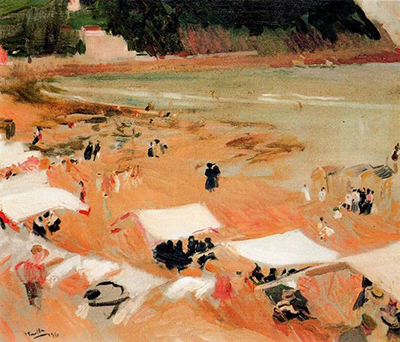 Buy Art Prints Now
Buy Art Prints Nowfrom Amazon
* As an Amazon Associate, and partner with Google Adsense and Ezoic, I earn from qualifying purchases.
This painting is believed to have been a fairly brisk artwork from 1910 in which Joaquin Sorolla composes the layout for a follow-up piece, but without including too much detail here. He concentrates on form and expression, so most elements can be identified but he would not consider this a completed piece in its own right.
This artwork features a series of small huts or tents with white cloth roofs. The beach area is covered in its entirety, from a carefully chosen angle that allows us to also view the sea and an area of landscape in the background. There is a relaxed atmosphere here, with people dotted about but without any crowding. Some natural elements can also be found close to the shoreline, which could potentially be seaweed or some shrubs or flowers. The artist keeps everything fairly abstract here, with forms suggested at but we can still make out most of the scene fairly easily. The figures are simple dabs of paint, just enough to produce an approximate line of the body, but without anymore that takes them out of their anonymous nature.
Joaquin Sorolla adored life on the beach, and would use such a setting many times within his career. He was most comfortable in his native Valencia, and would use their beaches as the backdrop to a number of artworks in which he consistently tweaked angles and content. Human figures would normally be present in one guise or another, and he covered a variety of them in different situations. He would capture children playing for example, as well as fishermen going about their daily work. There would also be a number of yachts and working vessels plus also some cattle on occasions who would be helping out the transfer of boats from sea to land and vice versa. He clearly understood and loved the variety of activities to be found here and there would even be some photographs of him perched by the beach working intently. Few styles have ever been more suitable to this region, either, as his later work was saturated in light and bright colours which were surely a direct influence of the environment around him.
The artist certainly took time to achieve fame and fortune, and it was a number of decades before he would consider himself and his family to have a true financial security. It was then that he was able to work with more freedom within his career and not only work on items that he knew would sell. There were also a number of portraits of his own family that were well received in exhibitions by local experts, but he would normally refuse to sell them because of their personal value. Those would then end up being passed on to his foundation, and eventually into the Sorolla Museum in Madrid which continues to this day. They successfully remind younger generations of the incredible qualities of this artist's work, with many shocked and astounded when they get to see some of his larger artworks in person for the first time. Despite a century having passed since his career was finished, his bright and expressive style still feels entirely contemporary and continues to draw new supporters all the time. Sorolla would also become good friends with another famous artist, John Singer Sargent, who gifted us some classics such as Carnation, Lily, Lily, Rose, Portrait of Madame X and Ellen Terry as Lady Macbeth.



